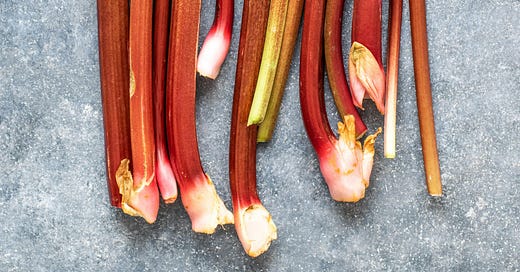Who discovered how to eat a plant that is sour and bitter when not cooked with enough sugar, has leaves that can sicken, even kill you, and only grows for a precious few weeks in Spring? Better yet, how many people had to die to show our surviving ancestors that it was edible, if one stuck to eating just the stock?
What actually is rhubarb?
Rheum rhabarbarum is native to Siberia, and has been used there and in Chinese medicine for thousands of years, to treat stomach aches and fevers. The English transported it from Asia in the 17th century, but first treated the leaves like a hearty chard-like green, eating only those. They learned the hard way that the leaves actually contain a toxic amount of oxalic acid and are poisonous. What would become a culinary love affair was put on a long pause. In the late 1700s the English discovered that the stalks are where it’s at, and began a tradition of baking them into “tarts,” so named because of the tart rhubarb. Shortly thereafter the plant was brought to the Americas, where it has been used in baking and cooking in myriad ways, ever since.
It grows in all sorts of climates. And what’s cool for a lazy gardener like myself, is that rhubarb is a perennial. The plant dies back in the Winter, but emerges again each Spring. My kind of edible. To add to your garden, try the Seed Bank for heirloom seeds, or Cottage Gardens and Petaluma Bounty for seedlings. Not all of us are going to grow it, to be sure. Thus, I have sourced the freshest stalks, and included one easy recipe for you to cook, if you so choose. In the case you don’t want to grow or cook it, Petaluma offers bakers and cooks that are top-notch so you don’t have to.
Where can you get the freshest?
FEED Sonoma is the go-to for all things local, organic, and nutrient-dense. You already know this if you’re a CSA member. If you’re not, you can sign up for a weekly farmbox and start cooking. The two farmers who are part of the FEED community and supply gorgeous rhubarb are Paul Wirtz of Paul’s Produce and Heidi Hermann of Strong Arm Farm.
If you venture outside of Petaluma to go to other Bay Area farmer’s markets, head down to the San Rafael Civic Center on Thursdays and Sundays where you can shop with Happy Quail Farms and Sea to Sky Farm. Both grow stunning rhubarb and are happy to share with you how they cook with it.
Cooks and bakers who use rhubarb
For those who don’t want to grow it, source it, or cook it, you’re in luck. You can buy ready-made treats at many local stops. Look no further than Stellina, Petaluma Pie Company, and Blooms End. All of these bakers use rhubarb in different ways. If you want to see how someone uses it in savory cooking, Chefs Stephane and Steven at Table Culture Provisions feature seasonal ingredients beautifully.
Easy rhubarb dessert
My favorite use is simple: poached in a sweet citrusy syrup and laid atop everything from French toast to yogurt to an achingly delicious Posset. Think of a Posset as a cousin to the pot de creme - the difference is a Posset doesn’t have eggs or gelatin, just cream, sugar, and citrus juice. An alchemy occurs when you stir the warm cream into the citrus juice, where it sets perfectly like a pudding.
Citrus Posset with Poached Rhubarb
Posset y = 4 8 oz portions
1 lemon and 1 orange washed, zest wide strips of both with a vegetable peeler
1/8 tspn salt
1/2 cup sugar
2 cups cream
1/2 cup juice from the lemon and orange
Directions:
Bring wide strips citrus, salt, sugar, cream to scalding (175 degrees) in medium saucepan over medium-high heat. Meanwhile, pour the citrus juice into a large pitcher. Place a fine mesh strainer over. Strain hot cream mix into citrus juice, pressing down on citrus peel to squeeze all the flavor out; stir well. Pour into serving containers. Put these in the fridge, uncovered for at least 2 hours but preferably overnight.
*once chilled: garnish with a heaping scoop of poached rhubarb.
Poached Rhubarb
2.5# rhubarb, large dice (cut off tips, split down middle, and wash)
1/2 cup honey
1/4 cup OJ
1 cinnamon stick
1 tablespoon minced ginger
1 vanilla bean, split or 1 teaspoon vanilla extract
Directions:
Place everything but the rhubarb in a large stock pot. Turn heat to med-high. Stir together until honey melts, and then add the rhubarb. Turn heat to medium, and cook until the fruit is at a simmer. Turn heat to low. Stir gently and occasionally, until rhubarb is tender. Takes about 15 minutes. Pour into a casserole dish to cool. Take out the vanilla bean, if used. If using for a posset, let cool completely in the fridge. Use the leftovers on yogurt, or bake with strawberries into muffins.




